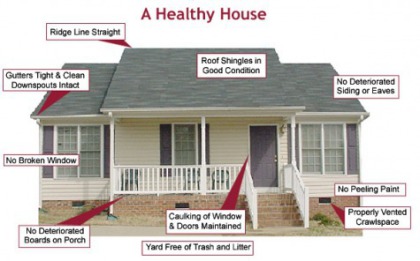Property Inspection
Residental Property Inspection
THE INSPECTION SYSTEM
THE BIG PICTURE
The first step in inspecting a home is to examine the big picture for the home. Notice the area the home is located in. Are there other homes of similar age and construction details relative to the home you are inspecting? A comparison will give you a general idea of the up keep of the home. Have there been significant modifications to the exterior of the building and if so, how is the workmanship?
EXTERIOR
Start at the exterior front of the house and work your way around the house (clockwise or counter-clockwise) at a distance which allows you to view a complete face comfortably. On each face (front, sides, rear) start your visual inspection at the top of the structure and work your way down to the ground and lot area. As an example, you would start at the front and note the roof and chimneys, the gutters, fascia and soffit's. Then, moving down the exterior wall coverings (brick, wood, aluminum), noting windows, doors, etc. Examine any porches or decks down to the foundation, then the grade or slope of the lot area, followed by any coverings, such as flower beds, walkway's, interlocking brick, driveways, etc. Move closer to the house, to examine more closely any details which may have attracted your attention, without skipping any items. Having completed the front, move to the side of the house and start the same procedure (roof to ground).
INTERIOR
On the interior, begin your inspection in the basement and then follow the system throughout each floor in the house. The system for inspecting the interior is to
begin with the floor, go to the walls and then the ceiling, and then consider any appliances or other items in the room. Move from room to room, always in the same direction (clockwise or
counter-clockwise) so as to not miss any areas. If you see a door, open it!
In the utility room in the basement, first notice the floor, the walls (possibly the foundation walls are visible here), then the ceiling (floor joists may be visible), then go to the
furnace, hot water heater, electrical panel, plumbing system, etc. When inspecting the floors, walls and ceilings, scan the entire areathat is visible, not just one section.
In a finished room you would notice the floors, walls (including windows) and ceiling. Next look for the heat sources, electrical outlets and switches, fireplaces, closets etc. In bathroom or
kitchen, notice the floor, walls and ceiling, then the plumbing fixtures.
CONDITION
While performing the inspection, whether at the exterior, the interior or one of the mechanical systems, note the system first, then its relative condition. For example, if you were inspecting a wall on the interior of the home you would first note that the wall is plaster, and then examine the wall for cracks and irregularities.
PROBLEMS
The following are some typical problems or occurrences to look for in the major components and systems of the home.
ROOF
Is the ridge (peak) showing a sag, or is it straight and level?
Is the roof sagging between the rafters or trusses?
Are there any signs of deterioration of asphalt shingles, such as curling, warping, broken edges, rounded corners or key holes(slits) becoming wider that normal?
Any loose flashing's, at the chimney, roof-to-wall connection or elsewhere?
Does the wooden roof deck appear rotten or delaminate under the last row of shingles?
Are there any roof vents visible?
CHIMNEYS
Is the masonry cap cracked or broken?
Are any bricks flaking or missing? Mortar missing?
Is the chimney leaning?
SOFFITS AND FASCIA
Note whether the soffit and fascia are wood, aluminum or plastic.
Any loose or missing sections?
If wood, are there any paint problems? Any visible rot?
GUTTERS AND DOWNSPOUTS
Ensure gutters slope down toward downspouts.
Any rust or peeling paint?
Apparent leaks or loose/sagging sections?
Are the downspouts extended away from the foundations?
WALL COVERINGS
Look for missing mortar
Are the bricks flaking or cracking?
Look for loose, missing or rotten siding, deteriorated paint.>
Does the siding appear new? Does it hide the foundation wall?
Exterior walls bowed, bulged or leaning?
WINDOWS AND DOORS
Look for problems with paint or caulking, and rotted wood components.
Are the windows new or older? Are they the original windows? How old are they?
PORCHES AND DECKS
Cracking or flaking masonry?
Check for paint problems, rotted wood, and wood-earth contact.
Note any settlement or separation from the house.
Inspect the underside, if accessible.
FOUNDATIONS
Check for cracks, flaking or damaged masonry.
Note any water markings and efflorescence (whitish, chalky substance)
Any bowing, bulging or other irregularities?
Soft mortar?
LOT AREA
Does the grade slope away from the house?
Any settled/low areas next to the foundation, or cracked walks/driveway?
Is the property lower than the street or neighboring properties?
BASEMENT
Note any evidence of water penetration (stains, mildew/odors, efflorescence, loose tiles etc.)
FLOORS
Check for deteriorated coverings or cracked ceramics.
Any water staining or other damage?
Sloping or sagging?
WALLS
Randomly sample to check that the windows and doors work.
Are the walls straight vertically and horizontally?
Look for cracked or loose plaster.
Look for stains, physical damage or previous repair evidence.
Any drywall seams or nails showing?
CEILINGS
Check for cracks in the plaster or loose, sagging plaster.
Look for stains, mechanical damage or evidence of previous repair.
Seams or nails showing?
BATHROOMS AND KITCHENS
Check that all fixtures are secure.
Are there any cracks in the fixtures?
Note the condition of the tiles and caulking in the tub/shower area.
Are the faucets working? Do they leak? Sufficient water pressure?
Look for staining and rot under the counter-tops
Randomly sample the operation of the cabinet doors and drawers.
ELECTRO-MECHANICAL CONSIDERATIONS
Type, style and age of heating & cooling systems. When were they last inspected or serviced?
Type of water supply piping and drains - any visible rust and corrosion?
Size and age of electrical service - are the outlets grounded? Visible wiring in good condition?
Have there been any upgrades?
Commercial Property
An ECG property condition report contains a property description (site, buildings, history, code compliance and maintenance) and a review of the following building components:
- Site Improvements (Access, Parking, Paving/Drainage, Walks/Curbs, Utilities, Lighting, Landscaping/Irrigation, Fences/Walls, Signage and Disabled Accessibility/ADA)
- Building Improvements (Foundation, Structure, Floor Construction, Exterior Wall Construction, Roof and Canopy Construction, Windows, Doors, Balconies/Terraces, Stairs, Interior Floors & Walls and Appliances/ Cabinets, Disabled Accessibility/ ADA)
- Building Mechanical, Plumbing & Electrical Systems (HVAC, Plumbing, Electrical, Vertical Transportation, Fire Protection/Life Safety Systems)
- Tenant Spaces (Interior Finishes, Kitchen Appliances, HVAC, Plumbing/Fixtures, Electrical, Fire Protection/Life Safety Systems)
- Other Issues (e.g., Fixtures, Furnishings and Equipment (FF&E) for hotels, more detailed mechanical studies, more detailed ADA surveys, etc.) -- these issues can be included in a property condition report, but must be discussed prior to being proposed





